Thermodynamic Picture of Dimer-Mott Organic Superconductors Revealed by Heat Capacity Measurements with External and Chemical Pressure Control
Abstract
:1. Introduction
2. Calorimetry Apparatus to Measure the Heat Capacity under Pressure
3. Heat Capacity of κ-(BEDT-TTF)2X under Pressure
4. Chemical Pressure Effect on Dimer-Mott Organic Compounds
5. Normal State Electronic Heat Capacity Coefficient γ and the Residual γ*
6. Conclusions
Acknowledgments
Author Contributions
Conflicts of Interest
References
- Ishiguro, T.; Yamaji, K.; Saito, G. Organic Superconductors; Springer: Heidelberg, Germany, 1998; pp. 1–245. [Google Scholar]
- Williams, J.M.; Ferraro, J.R.; Thorn, R.J.; Carlson, K.D.; Geiser, U.; Wang, H.-H.; Kini, A.M.; Whangbo, M.-H. Organic Superconductors; Prentice-Hall, Inc.: Upper Saddle River, NJ, USA, 1992; pp. 65–179. [Google Scholar]
- Lebet, A. The Physics of Organic Superconductors and Conductors; Springer: Berlin, Germany, 2008; pp. 1–704. [Google Scholar]
- Uji, S.; Mori, T.; Takahashi, T. Focus on Organic Conductors. Sci. Technol. Adv. Mater. 2009, 10, 020301. [Google Scholar] [CrossRef] [PubMed]
- Haddon, R.C.; Hebard, A.F.; Rosseinsky, M.J.; Murphy, D.W. Conducting films of C60 and C70 by alkali-metal doping. Nature 1991, 350, 320–322. [Google Scholar] [CrossRef]
- Palstra, T.T.M.; Zhou, O.; Iwasa, Y.; Sulewski, P.E.; Flemming, R.M.; Zegarski, B.R. Superconductivity at 40K in cesium doped C60. Solid State Commun. 1995, 93, 327–330. [Google Scholar] [CrossRef]
- Greene, R.L.; Street, G.B.; Suter, L.J. Superconductivity in Polysulfur Nitride (SN)x. Phys. Rev. Lett. 1975, 34, 577–579. [Google Scholar] [CrossRef]
- Kubozono, Y.; Mitamura, H.; Lee, X.; He, X.; Yamanari, Y.; Takahashi, Y.; Suzuki, Y.; Kaji, Y.; Eguchi, R.; Akaike, K.; et al. Metal-intercalated aromatic hydrocarbons: A new class of carbon-based superconductors. Phys. Chem. Chem. Phys. 2011, 13, 16476–16493. [Google Scholar] [CrossRef] [PubMed]
- Kagoshima, S.; Kato, R.; Fukuyama, H.; Seo, H.; Kino, H. Interplay of Structural and Electronic Properties. In Advances in Synthetic Metals Twenty Years of Progress in Science and Technology; Chapter 4; Elsevier: Lausanne, Switzerland, 1999; pp. 262–316. [Google Scholar]
- Mori, H. Materials Viewpoint of Organic Superconductors. J. Phys. Soc. Jpn. 2006, 75, 051003. [Google Scholar] [CrossRef]
- Kanoda, K. Metal-Insulator Transition in κ-(ET)2X and (DCNQI)2M: Two Contrasting Manifestation of Electron Correlation. J. Phys. Soc. Jpn. 2006, 75, 051007. [Google Scholar] [CrossRef]
- Kato, R. Development of π-Electron Systems Based on [M(dmit)2] (M = Ni and Pd; dmit: 1,3-dithiole-2-thione-4,5-dithiolate) Anion Radicals. Bull. Chem. Soc. Jpn. 2014, 87, 355–374. [Google Scholar] [CrossRef]
- Kino, H.; Fukuyama, H. Phase Diagram of Two-Dimensional Organic Conductors: (BEDT-TTF)2X. J. Phys. Soc. Jpn. 1996, 65, 2158–2169. [Google Scholar] [CrossRef]
- Kanoda, K. Recent progress in NMR studies on organic conductors. Hyperfine Interact. 1997, 104, 235–249. [Google Scholar] [CrossRef]
- Kanoda, K. Electron correlation, metal-insulator transition and superconductivity in quasi-2D organic systems, (ET)2X. Phys. C Superconduct. 1997, 287, 299–302. [Google Scholar] [CrossRef]
- Kobayashi, H.; Cui, H.; Kobayashi, A. Organic metals and superconductors based on BETS (BETS = bis(ethylenedithio)tetraselenafulvalene). Chem. Rev. 2004, 104, 5265–5288. [Google Scholar] [CrossRef] [PubMed]
- Fujiwara, H.; Kobayashi, H.; Fujiwara, E.; Kobayashi, A. An Indication of Magnetic-Field-Induced Superconductivity in a Bifunctional Layered Organic Conductor, κ-(BETS)2FeBr4. J. Am. Chem. Soc. 2002, 124, 6816–6817. [Google Scholar] [CrossRef] [PubMed]
- Kagawa, F.; Miyagawa, K.; Kanoda, K. Unconventional critical behaviour in a quasi-two-dimensional organic conductor. Nature 2005, 436, 534–537. [Google Scholar] [CrossRef] [PubMed]
- Gati, E.; Garst, M.; Manna, R.S.; Tutsch, U.; Wolf, B.; Bartosch, L.; Schubert, H.; Sasaki, T.; Schlueter, J.A.; Lang, M. Breakdown of Hooke’s law of elasticity at the Mott critical endpoint in an organic conductor. Sci. Adv. 2016, 2, e1601646. [Google Scholar] [CrossRef] [PubMed]
- Matsumura, Y.; Imajo, S.; Yamashita, S.; Akutsu, H.; Nakazawa, Y. Thermodynamic Investigation by Heat Capacity Measurements of κ-type Dimer-Mott Organic Compounds with Chemical Pressure Tuning. Int. J. Mod. Phys. B 2018, 32, 1840024. [Google Scholar] [CrossRef]
- Mori, H.; Tanaka, S.; Mori, T. Systematic study of the electronic state in θ-type BEDT-TTF organic conductors by changing the electronic correlation. Phys. Rev. B 1998, 57, 12023–12029. [Google Scholar] [CrossRef]
- McKenzie, R.H.; Merino, J.; Marston, J.B.; Sushkov, O.P. Charge ordering and antiferromagnetic exchange in layered molecular crystals of the θ type. Phys. Rev. B 2001, 64, 085109. [Google Scholar] [CrossRef]
- Miyagawa, K.; Kanoda, K.; Kawamoto, A. NMR Studies on Two-Dimensional Molecular Conductors and Superconductors: Mott Transition in κ-(BEDT-TTF)2X. Chem. Rev. 2004, 104, 5635–5654. [Google Scholar] [CrossRef] [PubMed]
- Arai, T.; Ichimura, K.; Nomura, K.; Takasaki, S.; Yamada, J.; Nakatsuji, S.; Anzai, H. Tunneling spectroscopy on the organic superconductor κ-(BEDT-TTF)2Cu(NCS)2 using STM. Phys. Rev. B 2001, 63, 104518. [Google Scholar] [CrossRef]
- Nakazawa, Y.; Kanoda, K. Low-temperature specific heat of κ-(BEDT-TTF)2Cu[N(CN)2]Br in the superconducting state. Phys. Rev. B 1997, 55, R8670–R8673. [Google Scholar] [CrossRef]
- Taylor, O.J.; Carrington, A.; Schlueter, J.A. Specific-Heat Measurements of the Gap Structure of the Organic Superconductors κ-(ET)2Cu[N(CN)2]Br and κ-(ET)2Cu(NCS)2. Phys. Rev. Lett. 2007, 99, 057001. [Google Scholar] [CrossRef] [PubMed]
- Girlando, A.; Masino, M.; Brillante, A.; Valle, R.G.D.; Venuti, E. BEDT-TTF organic superconductors: The role of phonons. Phys. Rev. B 2002, 66, 100507. [Google Scholar] [CrossRef]
- Sorai, M.; Nakazawa, Y.; Nakano, M.; Miyazaki, Y. Calorimetric Investigation of Phase Transitions Occurring in Molecule-Based Magnets. Chem. Rev. 2013, 113, PR41-122. [Google Scholar] [CrossRef] [PubMed]
- Gopal, E.S.R. Specific Heats at Low Temperature; Heywood Books: London, UK, 1966. [Google Scholar]
- Wosnitza, J. Quasi-Two-Dimensional Organic Superconductors. J. Low Temp. Phys. 2007, 146, 641–667. [Google Scholar] [CrossRef]
- Wosnitza, J. Superconductivity in Layered Organic Metals. Crystals 2012, 2, 248–265. [Google Scholar] [CrossRef]
- Muraoka, Y.; Imajo, S.; Yamashita, S.; Akutsu, H.; Nakazawa, Y. Thermal Anomaly around the Superconductive Transition of κ-(BEDT-TTF)2Cu(NCS)2 with External Pressure and Magnetic Field Control. J. Therm. Anal. Calorim. 2016, 123, 1891–1897. [Google Scholar] [CrossRef]
- Nakazawa, Y.; Yoshimoto, R.; Fukuoka, S.; Yamashita, S. Investigation on Electronic States of Molecule-Based Compounds by High-Pressure AC Calorimetry. Curr. Inorg. Chem. 2014, 4, 122–134. [Google Scholar] [CrossRef]
- Bachmann, R.; DiSalvo, F.J., Jr.; Geballe, T.H.; Greene, R.L.; Howard, R.E.; King, C.N.; Kirsch, H.C.; Lee, K.N.; Schwall, R.E.; Thomas, H.-U.; et al. Heat Capacity Measurements on Small Samples at Low Temperatures. Rev. Sci. Instrum. 1972, 43, 205–214. [Google Scholar] [CrossRef]
- Stewart, G.R. Measurement of low-temperature specific heat. Rev. Sci. Instrum. 1983, 54, 1–11. [Google Scholar] [CrossRef]
- Sorai, M. Comprehensive Handbook of Calorimetry and Thermal Analysis; Wiley: New York, NY, USA, 2004. [Google Scholar]
- Imajo, S.; Fukuoka, S.; Yamashita, S.; Nakazawa, Y. Construction of Relaxation Calorimetry for 101–2 Micro-gram Samples and Heat Capacity Measurements of Organic Complexes. J. Therm. Anal. Calorim. 2016, 123, 1871–1876. [Google Scholar] [CrossRef]
- Fukuoka, S.; Horie, Y.; Yamashita, S.; Nakazawa, Y. Development of Heat Capacity Measurement System for Single Crystals of Molecule-Based Compounds. J. Therm. Anal. Calorim. 2013, 113, 1303–1308. [Google Scholar] [CrossRef]
- Sullivan, P.F.; Seidel, G. Steady-State, ac-Temperature Calorimetry. Phys. Rev. 1968, 173, 679–685. [Google Scholar] [CrossRef]
- Eichler, A.; Gey, W. Method for the determination of the specific heat of metals at low temperatures under high pressures. Rev. Sci. Instrum. 1979, 50, 1445–1452. [Google Scholar] [CrossRef] [PubMed]
- Kubota, O.; Nakazawa, Y. Construction of a low-temperature thermodynamic measurement system. Rev. Sci. Instrum. 2008, 79, 053901. [Google Scholar] [CrossRef] [PubMed]
- Kubota, O.; Fukuoka, S.; Nakazawa, Y.; Nakata, K.; Yamashita, S.; Miyasaka, H. Thermodynamic Investigation of Coordination-Networked Systems of [Mn4] Single-Molecule Magnets under Pressure. J. Phys. Condens. Matter 2010, 22, 026007. [Google Scholar] [CrossRef] [PubMed]
- Tokoro, N.; Kubota, O.; Yamashita, S.; Kawamoto, A.; Nakazawa, Y. Thermodynamic Study of κ-(BEDT-TTF)2Ag(CN)2H2O under Pressures and with Magnetic Fields. J. Phys. Conf. Ser. 2008, 132, 012010. [Google Scholar] [CrossRef]
- Tokoro, N.; Fukuoka, S.; Kubota, O.; Nakazawa, Y. Low-temperature heat capacity measurements of κ-type organic superconductors under pressure. Phys. B Condens. Matter 2010, 405, S273–S276. [Google Scholar] [CrossRef]
- Danda, M.; Muraoka, Y.; Yamamoto, T.; Nakazawa, Y. High-Pressure AC Calorimetry System Using Pt Chip Thermometer. Netsu Sokutei 2012, W39, 29–32. [Google Scholar]
- Konoike, T.; Uchida, K.; Osada, T. Specific Heat of the Multilayered Massless Dirac Fermion System. J. Phys. Soc. Jpn. 2013, 81, 043601. [Google Scholar] [CrossRef]
- Naito, A.; Nakazawa, Y.; Saito, K.; Taniguchi, H.; Kanoda, K.; Sorai, M. Anomalous enhancement of electronic heat capacity in the organic conductors κ-(BEDT-TTF)4Hg3−δX8 (X = Br, Cl). Phys. Rev. B 2005, 71, 054514. [Google Scholar] [CrossRef]
- Yamashita, S.; Naito, A.; Nakazawa, Y.; Saito, K.; Taniguchi, H.; Kanoda, K.; Oguni, M. Drastic cooling rate dependence of thermal anomaly associated with the superconducting transition in κ-(BEDT-TTF)4Hg2.89Br8. J. Therm. Anal. Calorim. 2005, 81, 591–594. [Google Scholar] [CrossRef]
- Nakazawa, Y.; Yamashita, S. Thermodynamic Properties of κ-(BEDT-TTF)2X Salts: Electron Correlations and Superconductivity. Crystals 2012, 2, 741–761. [Google Scholar] [CrossRef]
- Yamashita, S.; Ishikawa, T.; Fujisaki, T.; Naito, A.; Nakazawa, Y.; Oguni, M. Thermodynamic behavior of the 10 K class organic superconductor κ-(BEDT-TTF)2Cu(NCS)2 studied by relaxation calorimetry. Thermochim. Acta 2005, 431, 123–126. [Google Scholar] [CrossRef]
- Ishikawa, T.; Nakazawa, Y.; Ymashita, S.; Oguni, M.; Saito, K.; Takimiya, K.; Otsubo, T. Thermodynamic Study of an Incommensurate Organic Superconductor. (MDT-TSF)(AuI2)0.436. J. Phys. Soc. Jpn. 2006, 75, 074606. [Google Scholar] [CrossRef]
- Katsumoto, S.; Kobayashi, S.; Urayama, H.; Yamochi, H.; Saito, G. Low-Temperature Specific Heat of Organic Superconductor κ-(BEDT-TTF)2Cu(NCS)2. J. Phys. Soc. Jpn. 1988, 57, 3672–3673. [Google Scholar] [CrossRef]
- Andraka, B.; Kim, J.S.; Stewart, G.R.; Calson, K.D.; Wang, H.H.; Williams, J.M. Specific heat in high magnetic field of κ-di[bis(ethylenedithio)tetrathiafulvalene]-di(thiocyano)cuprate [κ-(ET)2Cu(NCS)2]: Evidence for strong-coupling superconductivity. Phys. Rev. B 1989, 40, 11345–11347. [Google Scholar] [CrossRef]
- Graebner, J.E.; Haddon, R.C.; Chichester, S.V.; Glarum, S.H. Specific heat of superconducting κ-(BEDT-TTF)2Cu(NCS)2 near Tc [where BEDT-TTF is bis(ethylenedithio)tetrathiafulvalene]. Phys. Rev. B 1990, 41, 4808–4810. [Google Scholar] [CrossRef]
- Müller, J.; Lang, M.; Helfrich, R.; Steglich, F.; Sasaki, T. High-resolution ac-calorimetry studies of the quasi-two-dimensional organic superconductor κ-(BEDT-TTF)2Cu(NCS)2. Phys. Rev. B 2002, 65, 140509. [Google Scholar] [CrossRef]
- Lortz, R.; Wang, Y.; Demuer, A.; Böttger, P.H.M.; Bergk, B.; Zwicknagl, G.; Nakazawa, Y.; Wosnitza, J. Calorimetric Evidence for a Fulde-Ferrell-Larkin-Ovchinnikov Superconducting State in the Layered Organic Superconductor κ-(BEDT-TTF)2Cu(NCS)2. Phys. Rev. Lett. 2007, 99, 187002. [Google Scholar] [CrossRef] [PubMed]
- Elsinger, H.; Wosnizta, J.; Wanka, S.; Hagel, J.; Schweitzer, D.; Strunz, W. κ-(BEDT-TTF)2Cu[N(CN)2]Br: A Fully Gapped Strong-Coupling Superconductor. Phys. Rev. Lett. 2000, 84, 6098–6101. [Google Scholar] [CrossRef] [PubMed]
- Ishikawa, T.; Yamashita, S.; Nakazawa, Y.; Kawamoto, A.; Oguni, M. Calorimetric study of molecular superconductor κ-(BEDT-TTF)2Ag(CN)2H2O which contains water in the anion layers. J. Therm. Anal. Calorim. 2008, 92, 435–438. [Google Scholar] [CrossRef]
- Wosnitza, J.; Liu, X.; Schweitzer, D.; Keller, H.J. Specific heat of the organic superconductor κ-(BEDT-TTF)2I3. Phys. Rev. B 1994, 50, 12747–12751. [Google Scholar] [CrossRef]
- Imajo, S.; Yamashita, S.; Akutsu, H.; Nakazawa, Y. Quadratic Temperature Dependence of Electronic Heat Capacities in the κ-Type Organic Superconductors. Int. J. Mod. Phys. B 2016, 30, 1642014. [Google Scholar] [CrossRef]
- Nakazawa, Y.; Taniguchi, H.; Kawamoto, A.; Kanoda, K. Electronic specific heat at the boundary region of the metal-insulator transition in the two-dimensional electronic system of κ−(BEDT-TTF)2Cu[N(CN)2]Br. Phys. Rev. B 2000, 61, R16295–R16298. [Google Scholar] [CrossRef]
- Nakazawa, Y.; Taniguchi, H.; Kawamoto, A.; Kanoda, K. Electronic specific heat of BEDT-TTF-based organic conductors. Phys. B Condens. Matter 2000, 281–282, 899–900. [Google Scholar] [CrossRef]
- Brinkman, W.F.; Rice, T.M. Application of Gutzwiller’s Variational Method to the Metal-Insulator Transition. Phys. Rev. B 1970, 2, 4302–4304. [Google Scholar] [CrossRef]
- McWhan, D.B.; Remeika, J.P.; Rice, T.M.; Brinkman, W.F.; Maita, J.P.; Menth, A. Electronic Specific Heat of Metallic Ti-Doped V203. Phys. Rev. Lett. 1971, 27, 941–943. [Google Scholar] [CrossRef]
- Tokura, Y.; Taguchi, Y.; Okada, Y.; Fujishima, Y.; Arima, A.; Kumagai, K.; Iye, Y. Filling dependence of electronic properties on the verge of metal–Mott-insulator transition in Sr1−xLaxTiO3. Phys. Rev. Lett. 1993, 70, 2126–2129. [Google Scholar] [CrossRef] [PubMed]
- Imajo, S.; Kanda, N.; Yamashita, S.; Akutsu, H.; Nakazawa, Y.; Kumagai, H.; Kobayashi, T.; Kawamoto, A. Thermodynamic Evidence of d-Wave Superconductivity of the Organic Superconductor λ-(BETS)2GaCl4. J. Phys. Soc. Jpn. 2016, 85, 043705. [Google Scholar] [CrossRef]
- Stewart, G.R.; Williams, J.M.; Wang, H.H.; Hall, L.N.; Perozzo, M.T.; Carlson, K.D. Bulk superconducting specific-heat anomaly in β-di[bis (ethylenedithio) tetrathiafulvalene] diiodoaurate [β-(ET)2AuI2]. Phys. Rev. B 1986, 34, 6509–6510. [Google Scholar] [CrossRef]
- Andres, K.; Schwenk, H.; Veith, H. Peculiarities of Organic Superconductors of the (BEDT-TTF)2X Family. Phys. B+C 1986, 143, 334–337. [Google Scholar] [CrossRef]
- Matsuzaki, T.; Momono, N.; Oda, M.; Ido, M. Electronic specific heat of La2-xSrxCuO4: Pseudogap formation and reduction of the superconducting condensation energy. J. Phys. Soc. Jpn. 2004, 73, 2232–2238. [Google Scholar] [CrossRef]
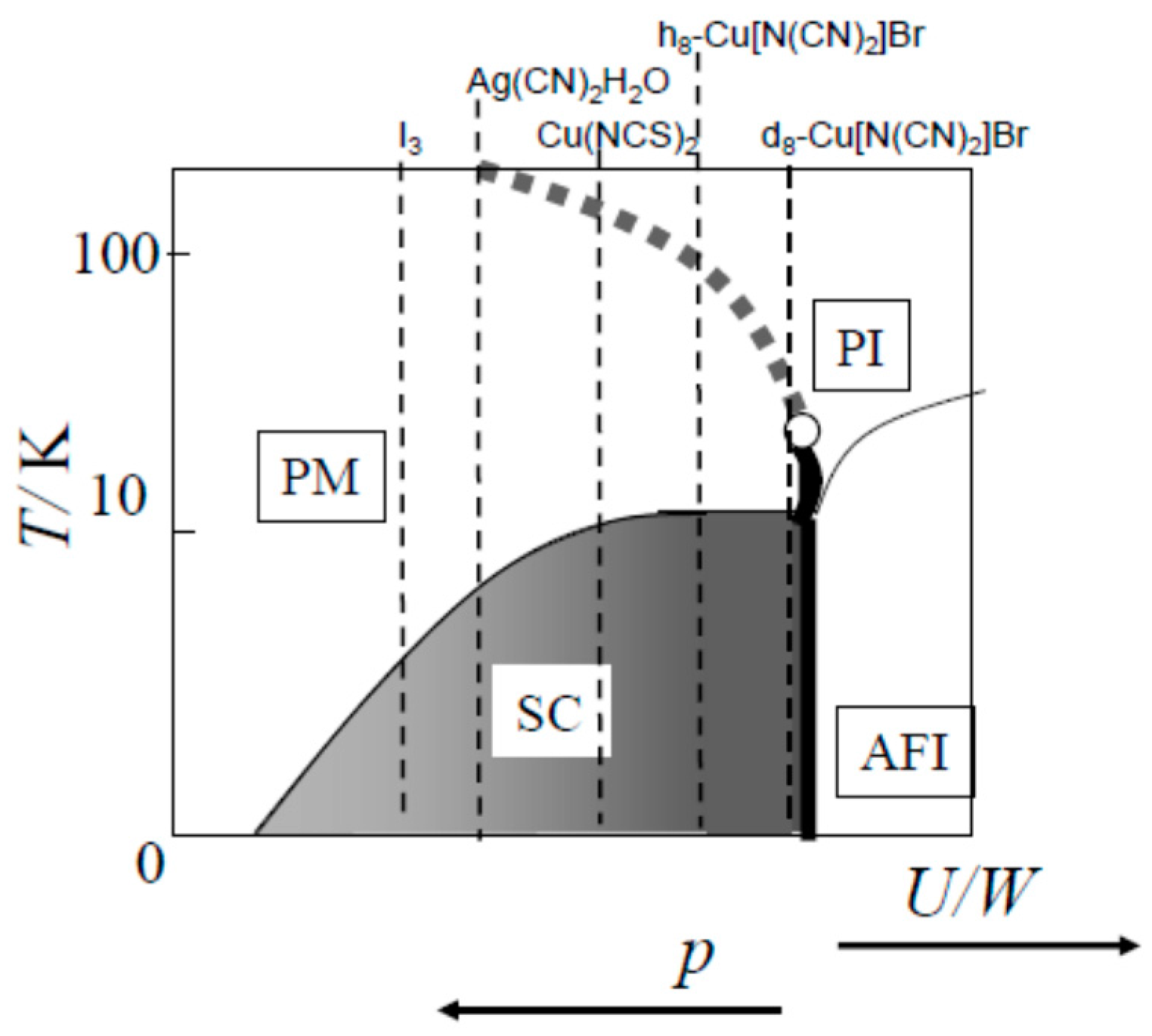
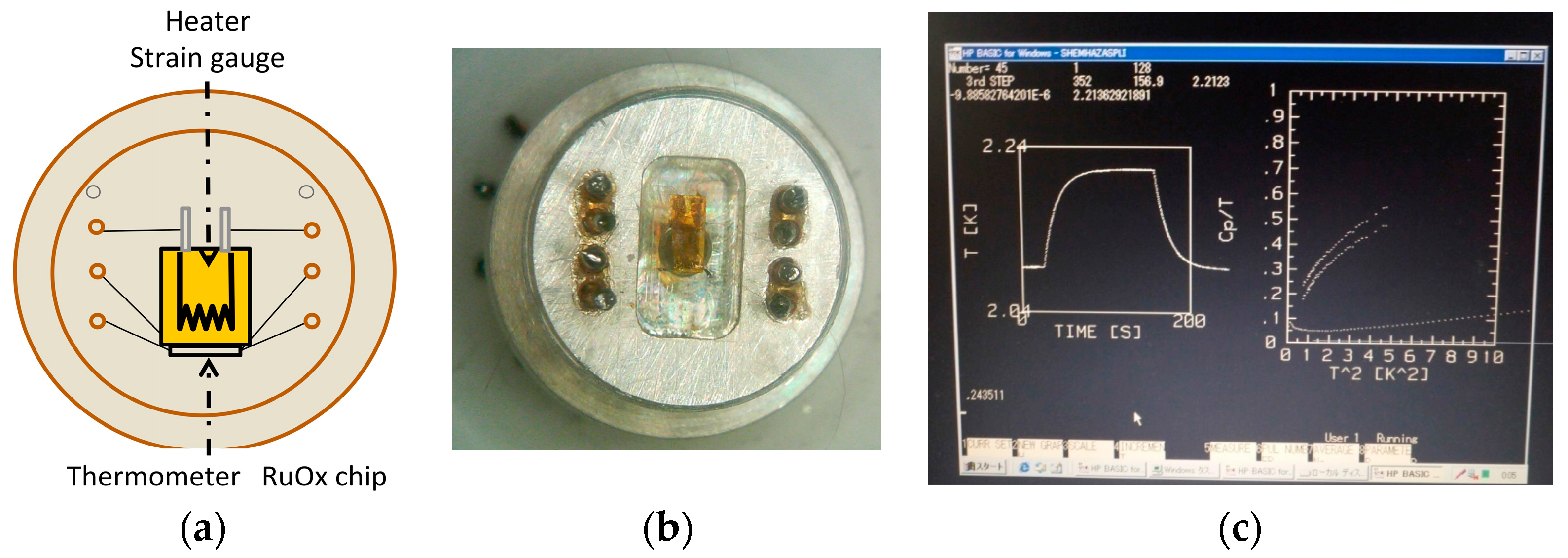
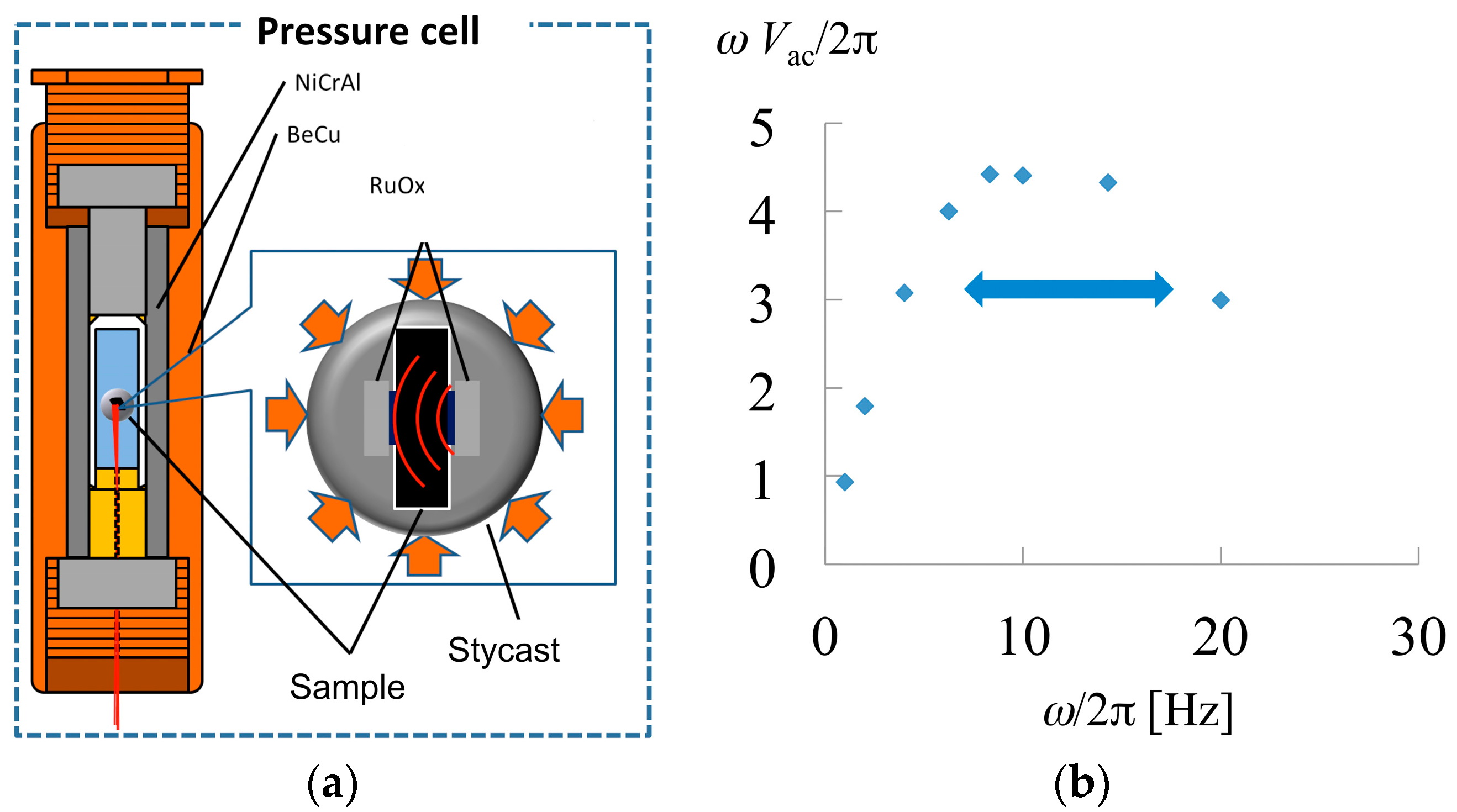
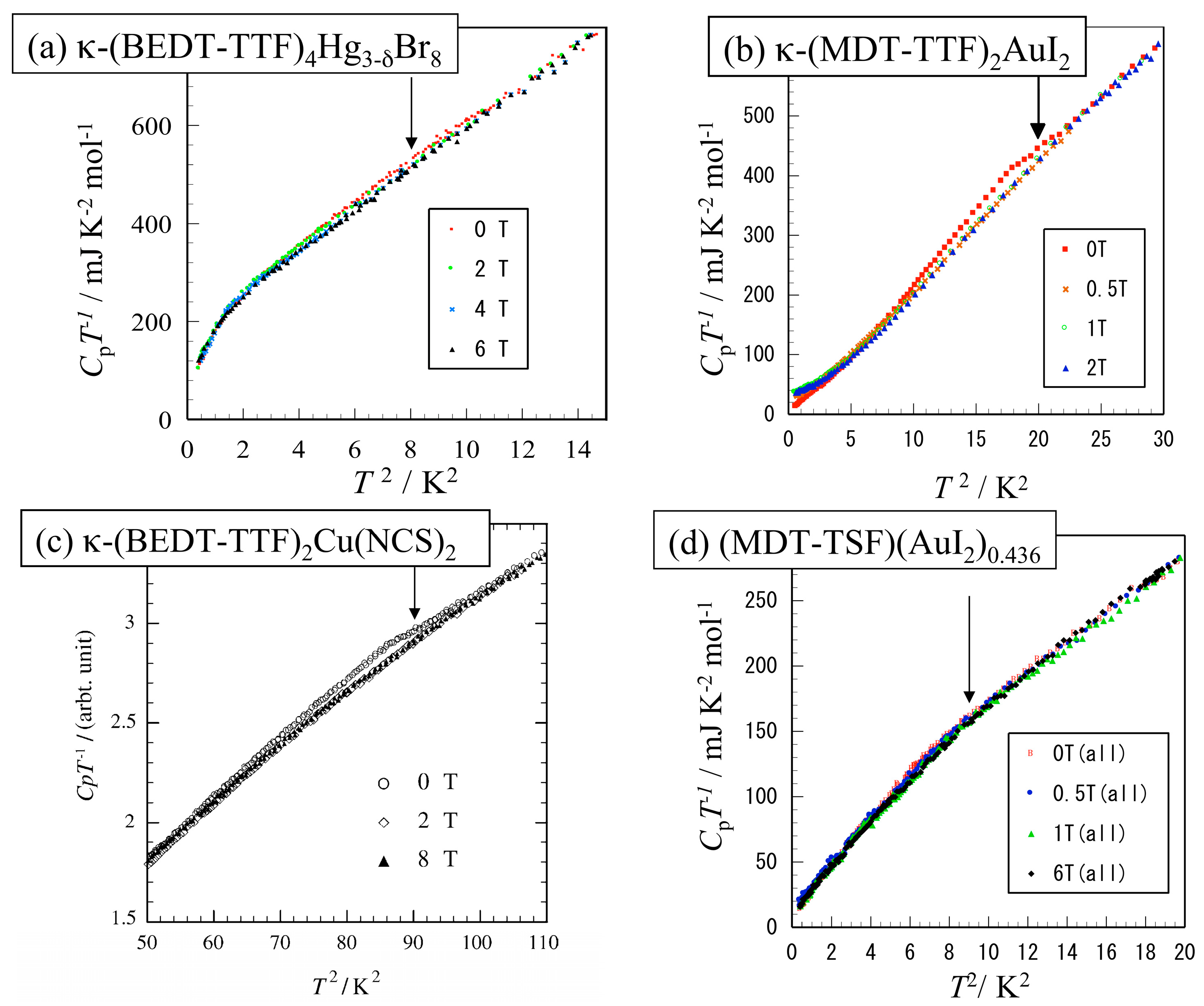
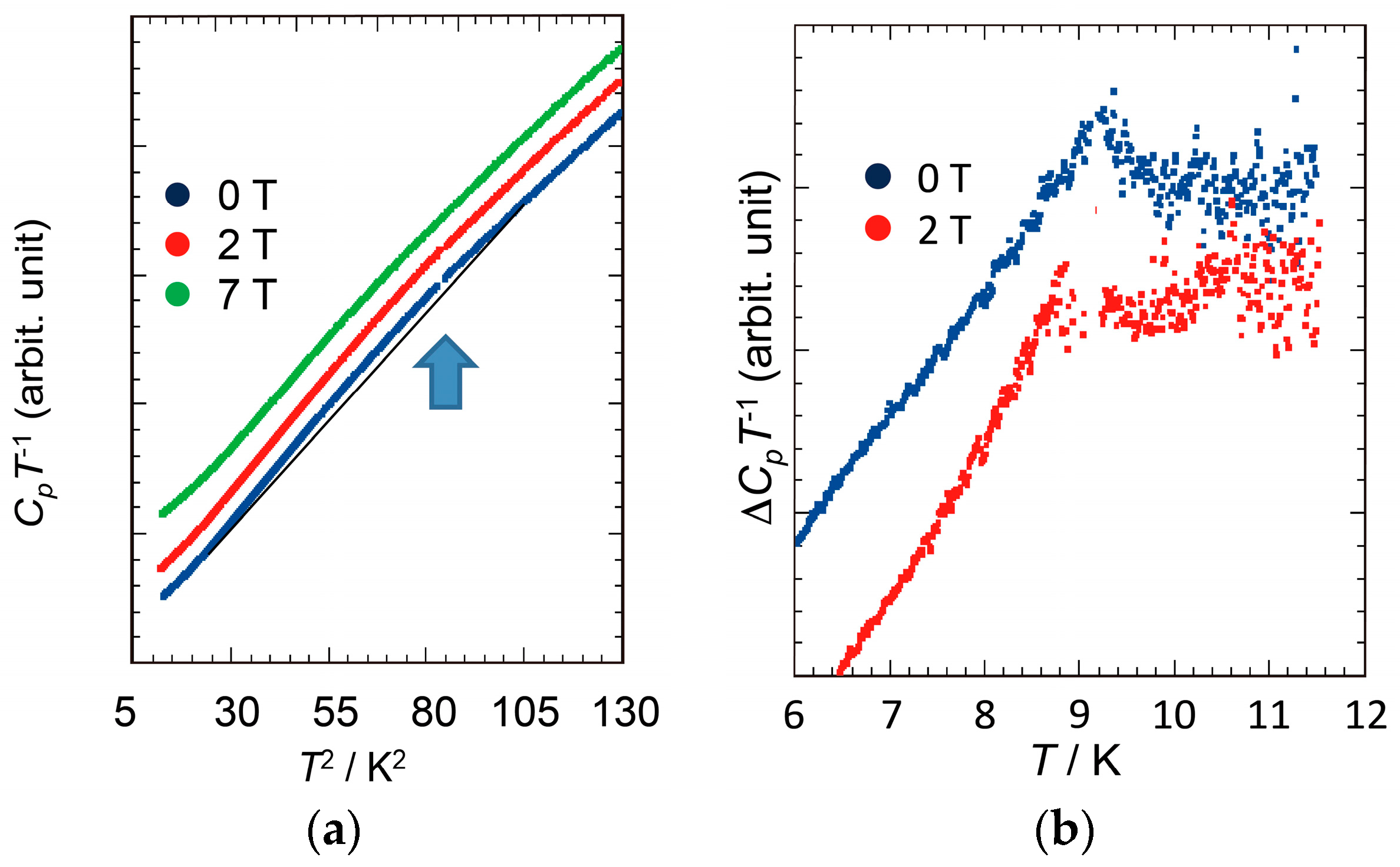
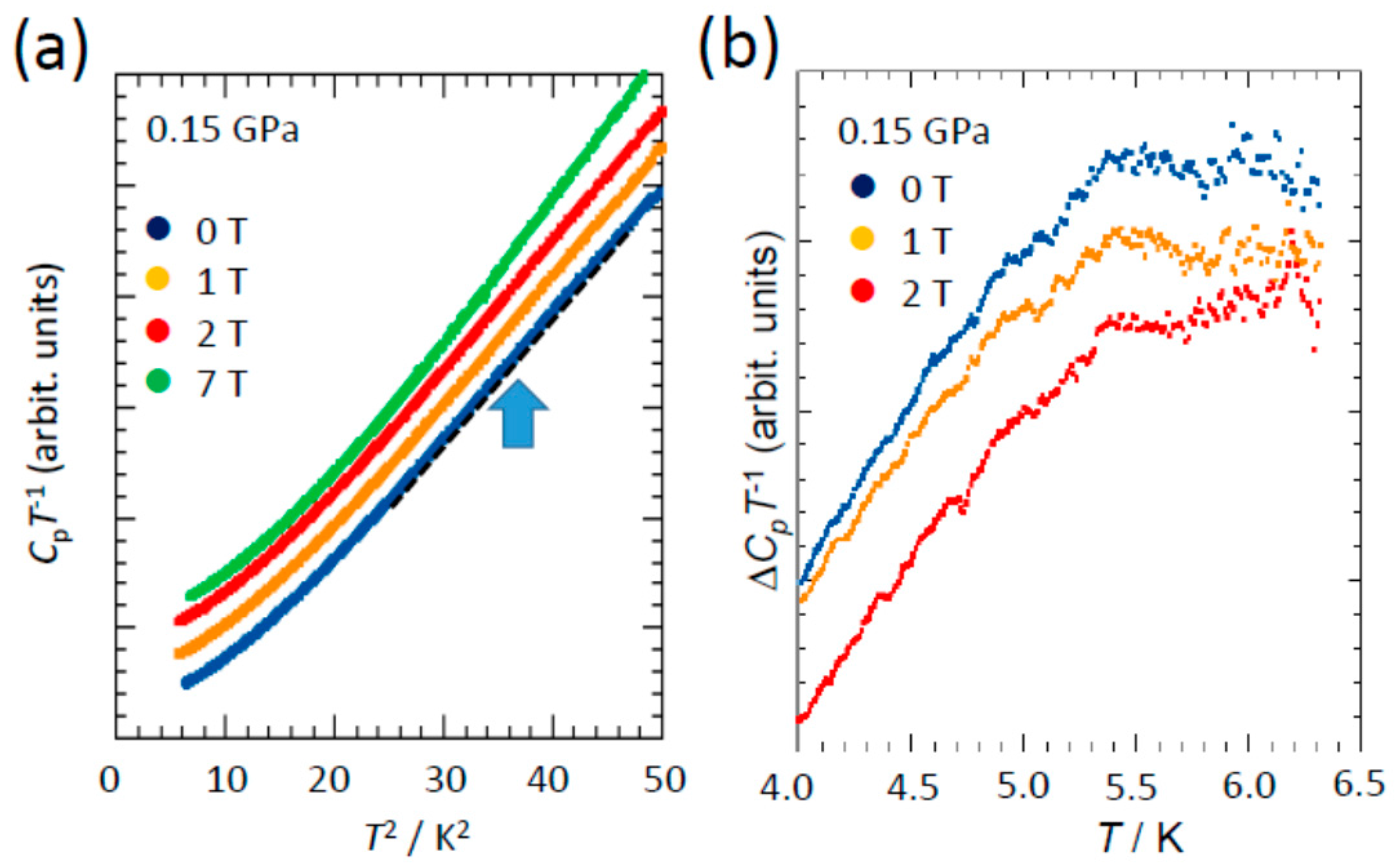
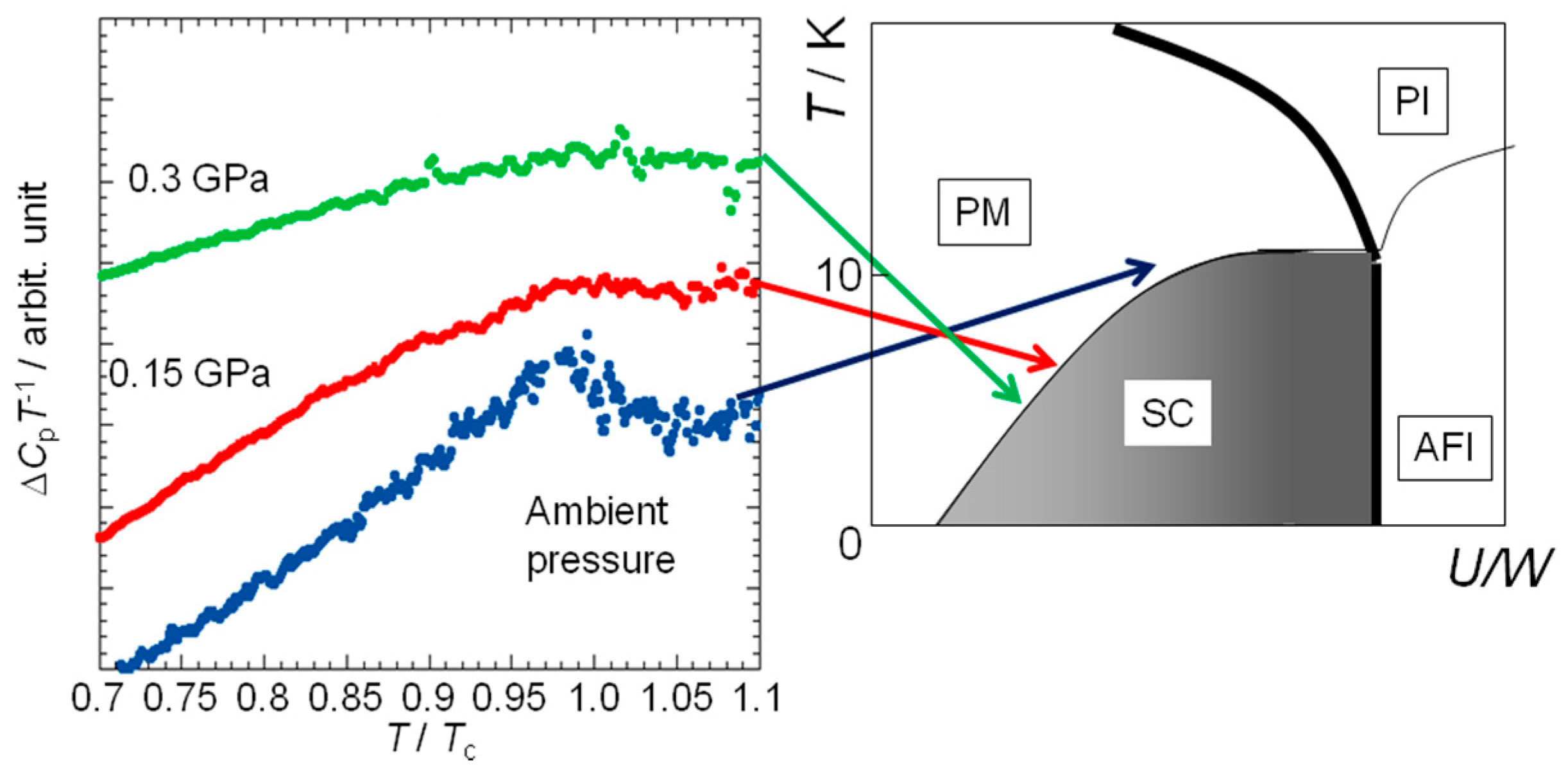

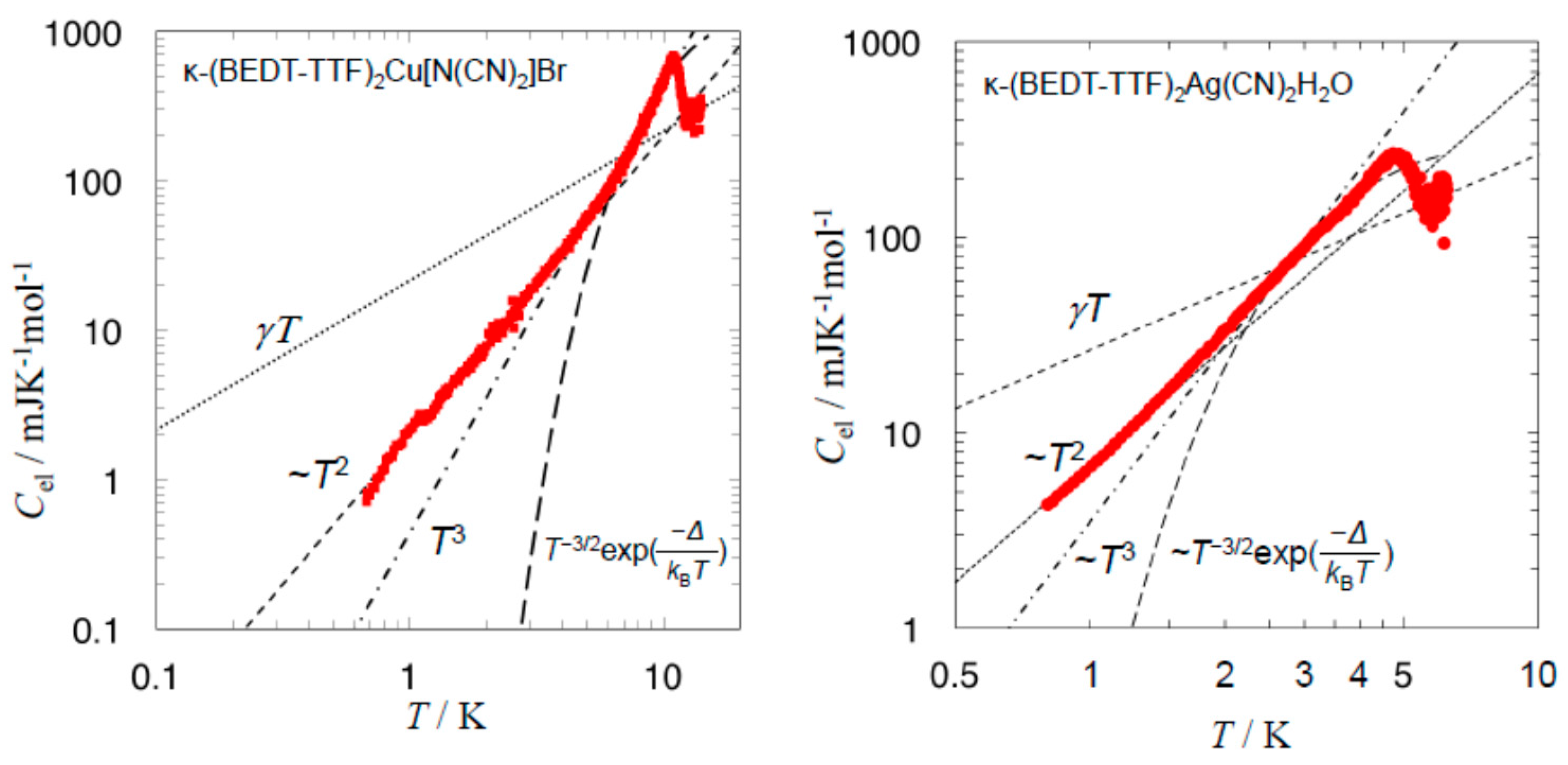
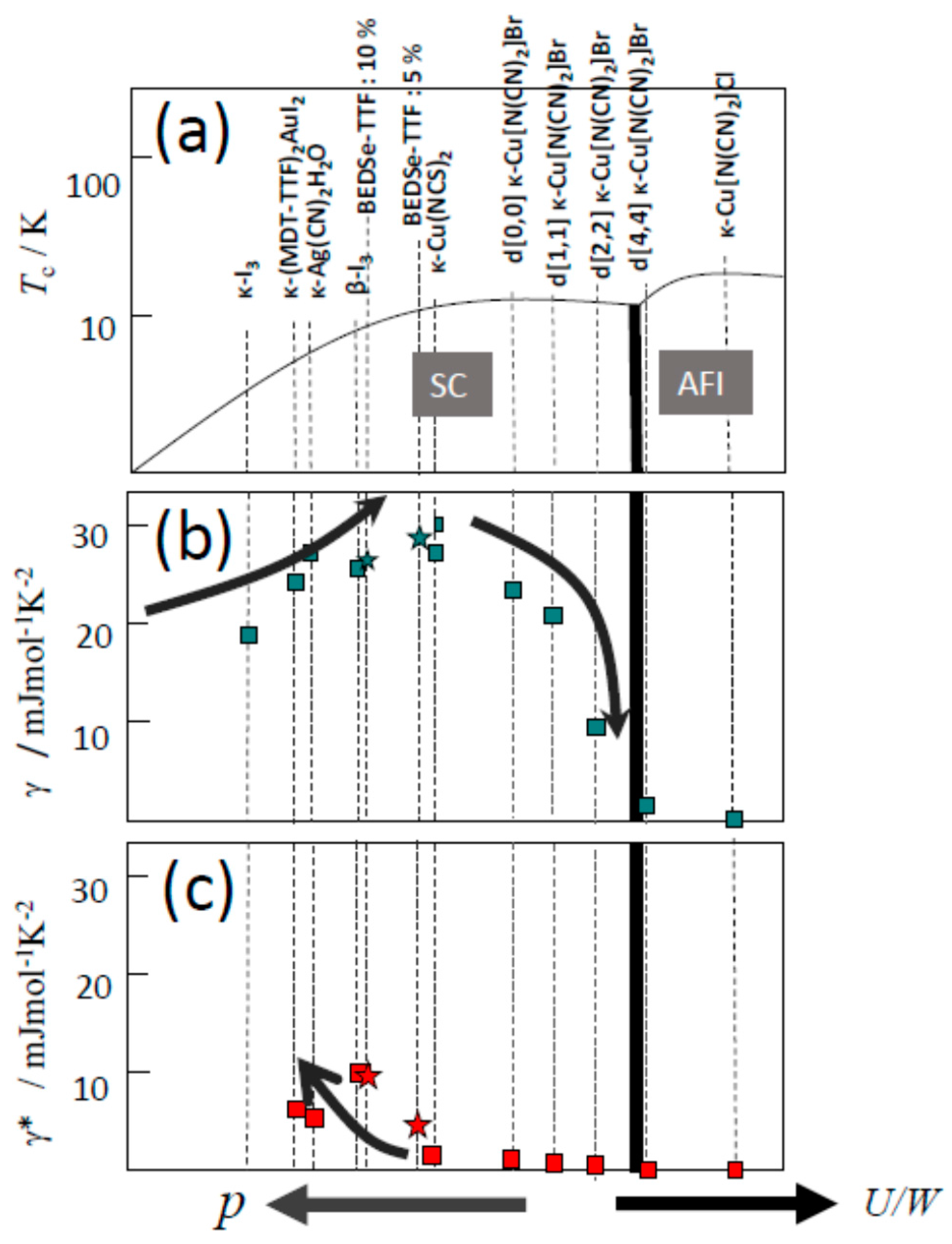
© 2018 by the authors. Licensee MDPI, Basel, Switzerland. This article is an open access article distributed under the terms and conditions of the Creative Commons Attribution (CC BY) license (http://creativecommons.org/licenses/by/4.0/).
Share and Cite
Nakazawa, Y.; Imajo, S.; Matsumura, Y.; Yamashita, S.; Akutsu, H. Thermodynamic Picture of Dimer-Mott Organic Superconductors Revealed by Heat Capacity Measurements with External and Chemical Pressure Control. Crystals 2018, 8, 143. https://doi.org/10.3390/cryst8040143
Nakazawa Y, Imajo S, Matsumura Y, Yamashita S, Akutsu H. Thermodynamic Picture of Dimer-Mott Organic Superconductors Revealed by Heat Capacity Measurements with External and Chemical Pressure Control. Crystals. 2018; 8(4):143. https://doi.org/10.3390/cryst8040143
Chicago/Turabian StyleNakazawa, Yasuhiro, Shusaku Imajo, Yuki Matsumura, Satoshi Yamashita, and Hiroki Akutsu. 2018. "Thermodynamic Picture of Dimer-Mott Organic Superconductors Revealed by Heat Capacity Measurements with External and Chemical Pressure Control" Crystals 8, no. 4: 143. https://doi.org/10.3390/cryst8040143




